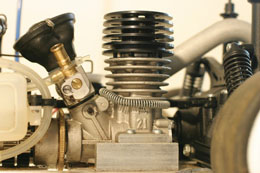
Of the many inventions that drove the industrial revolution, one that deserves a place, right up there with the best, is the internal combustion engine, which drives every vehicle around the world. Most people are familiar with the four-stroke engine design, which is the default type that is installed in today’s cars, but very few know about the two-stroke design. Both are based on the same principle of internal combustion, but differ in design and efficiency.
Both designs consist of a closed-engine cylinder with a piston, fuel injection, and ignition systems fitted in. An air-fuel mixture is pumped into the compartment which is compressed with a piston stroke and then ignited by a spark injection to produce the motive force that drives piston movement.
The oscillatory motion created by fuel combustion, under compression, is converted into a torque motion that ultimately drives the car forward.
How are They Different?
Just like a beating heart, a car or motorbike engine must function incessantly to maintain motion. Though the end result is the same, the two mechanisms differ in the way every engine cycle is executed. Let us look at the difference in designing and functioning of the two.
Design and Functioning
Picture a piston moving up and down in a cylinder. A four-stroke engine consists of many engine cylinders with pistons fitted into each, along with intake and exhaust valves. At the beginning of the engine cycle, the piston travels down, opening the intake valve and allowing an air-fuel mixture to enter the cylinder (this is the intake stroke). Then the piston moves up to compress the mixture, which leads to an increase in density and pressure (this is called the compression stroke).
At this point the spark plug comes into action, igniting the highly dense mixture, with an explosive force, which sends the piston moving down again (this is known as a combustion stroke). This motion of the piston drives the crankshaft, generating the torque required for forward motion. Then the piston moves up again in the cylinder to drive out the left over exhaust gases (this is known as the exhaust stroke). These four strokes complete one engine cycle, which goes on repeating itself, driving the car forward. In diesel engines, spark plug is not required as diesel ignites spontaneously during compression but it is an inseparable part of petrol engines.
The two-stroke engine is so designed and named, as its cycle involves only two strokes. There are no intake and exhaust valves in its design. The intake and exhaust strokes happen during the compression and combustion strokes.
This is made possible by the facility of two ports in the engine cylinder wall, which take in the air-fuel mixture and send the exhaust gases out. During the combustion stroke, the piston travels downwards, opening up the outlet port, through which the exhaust gases are ejected.
Consequently, during the compression stroke, the exhaust port is closed and inlet port exposed, through which air-fuel mixture is sucked in. The prime difference in these two designs is that, while a four-stroke engine is fired during every alternate revolution, the two-stroke engine fires during every piston revolution; packing in more power in the process.
Efficiency
Though the simpler design provides the two-stroke engine with more power and makes them less expensive, they score poorly when it comes to mileage and emission levels. It wears out fast, due to lack of a proper lubrication system, which exists in the four-stroke variety. For two-stroke engine tuning, engine oil needs to be added, along with fuel. It consumes fuel faster and pollutes a lot more due to its simpler design, besides being quite noisy.
So, the added power of the two-stroke engine comes at the price of efficiency and pollution. Its troubleshooting is simpler compared to the other variety. Four-stroke engines use up fuel much more efficiently and pollute less due to the valve mechanism. If you need mileage and efficiency, four-stroke engines are the default choice.
As our discussion above has revealed, four-stroke engine design is more efficient and less polluting of the two alternatives, which is exactly the reason why it is the most preferred design of car manufacturers.